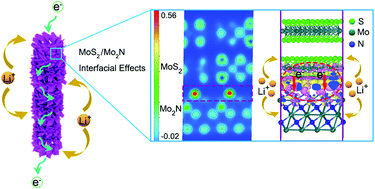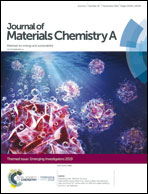Rational construction of MoS2/Mo2N/C hierarchical porous tubular nanostructures for enhanced lithium storage†
Abstract
As a promising anode material with a graphite-like layered structure for lithium ion batteries (LIBs), molybdenum disulfide (MoS2) suffers from poor electrical conductivity and rapid capacity fading. A heterostructure with conductive phases is considered as an effective solution to tackle these challenges, while rational construction and elaborate engineering of the heterostructure with maximized advantages from each component is highly desirable. Herein, we report the fabrication of a unique heterostructure composed of MoS2/Mo2N with nitrogen doped carbon (MoS2/Mo2N/C) via a stepwise cooperative assembly-directed strategy. Instead of using traditional NH3, a Mo2N based heterostructure was formed by in situ stepwise nitridation of Mo sources with dopamine and thiourea. The hierarchical porous tubular nanostructure with high electrical conductivity showed a remarkable electrochemical performance with a high specific capacity (945 mA h g−1 at 0.1 A g−1) and excellent cycling stability, which makes it one of the best Mo-based materials. Confirmed by density functional theory (DFT) calculations, introduction of Mo2N with abundant nitrogen vacancies generated an interfacial electric field in MoS2/Mo2N heterojunctions, which promotes charge transfer and electrochemical reaction kinetics. This work provides possible strategies for the development of high performance heterostructured electrodes for LIBs and other energy storage devices.

- This article is part of the themed collection: Journal of Materials Chemistry A Emerging Investigators


 Please wait while we load your content...
Please wait while we load your content...